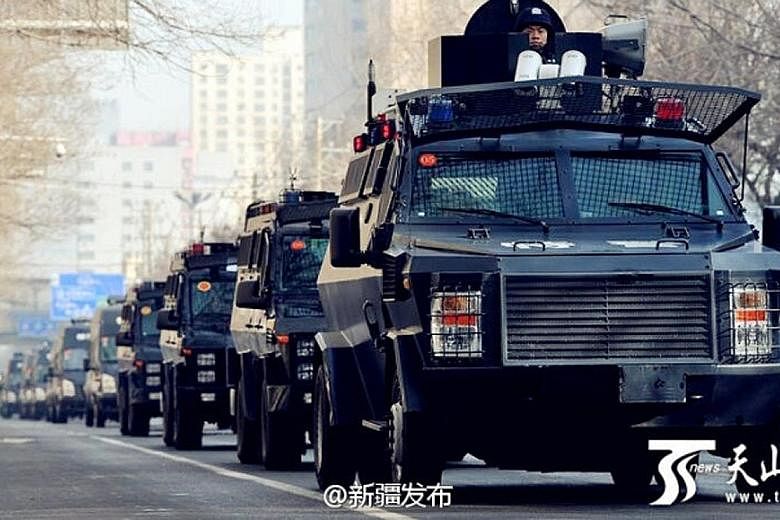BEIJING • The Chinese authorities have ordered all motor vehicles in Bayingol prefecture in far-western Xinjiang to be installed with mandatory Global Positioning System-style tracking devices, the latest tough anti-terror measure targeting the ethnically divided region.
China has been stepping up already tight security in restive Xinjiang after a rise in violence in recent months.
Hundreds have been killed in Xinjiang in the past few years, mostly in unrest between the Muslim Uighur people, who call the region home, and the ethnic majority Han Chinese. Beijing blames the unrest on Islamist militants.
"Cars are the main transportation means for terrorists, and are also a frequently chosen tool to carry out terrorist attacks," the Bayingol traffic police said on their Weibo microblog account on Feb 4.
All vehicles will be required by June 30 to install satellite tracking devices connected to China's proprietary Beidou navigation satellite, "so they can be tracked wherever they go", the state-run Global Times reported yesterday.
It would also help owners to find their cars quickly if they are stolen by terrorists, the report said. Owners of cars not fitted with the devices will be unable to buy petrol at service stations in Bayingol, or sell the cars on the second-hand market.
Remote and sparsely populated Bayingol occupies a huge part of south-east Xinjiang, although most of the violence has been concentrated further away near Kashgar and Hotan in the southern Uighur heartland.
The government has blamed separatist Islamist militants for most of the unrest, although rights groups and exiles say anger at tightening Chinese controls on the religion and culture of Muslim Uighurs is more to blame.
China routinely denies any repression in Xinjiang.
Violence has continued to flare particularly in the more remote southern regions of Xinjiang, although accounts are difficult to verify independently and exiles and rights groups suspect incidents are under-reported.
Last week, Chinese security forces in the regional capital of Urumqi and the Uighur hub of Hotan staged large-scale anti-terror rallies, parading thousands of armed police and paramilitary officers, as well as dozens of armoured vehicles, through city streets.
About 10,000 police officers and members of the People's Armed Police, a paramilitary force responsible for domestic security, attended a rally last Saturday in a central square in Urumqi, the regional capital, according to a report on the Xinjiang government's official website. Hundreds of police vans and other official vehicles also filled the square.
The rallies were the biggest in recent years, if statistics cited by official websites are accurate.
Last year, Mr Chen Quanguo, the former Communist Party chief of the Tibet Autonomous Region, where ethnic tensions are also a chronic problem, was appointed to be the party chief of Xinjiang.
His predecessor in Xinjiang, Mr Zhang Chunxian, was seen by some central government officials as being too lenient. Mr Chen, an ethnic Han known for tough policies in Tibet, has tried to project an uncompromising image in Xinjiang.
"The new regime of Chen Quanguo not only wants to look tough on terror in the eyes of the Han and Uighur population of the Xinjiang Uighur Autonomous Region, but also wants to send a message back to Zhongnanhai that his regime is going to take a more hard-line stance on terror when compared to his predecessor Zhang Chunxian," Professor James Leibold, a scholar of Xinjiang and China's ethnic policies at La Trobe University in Australia, said. Zhongnanhai is the name of the Communist Party's leadership compound in central Beijing.
Last week, three knife-wielding attackers were shot dead after killing five people in Pishan County, in Hotan prefecture. Last December, five people were killed when attackers drove a vehicle into a government building, with police shooting dead the three perpetrators.
REUTERS, NYTIMES

